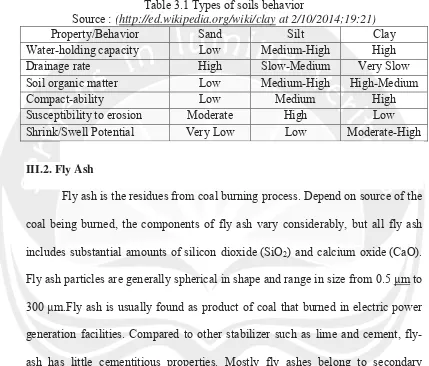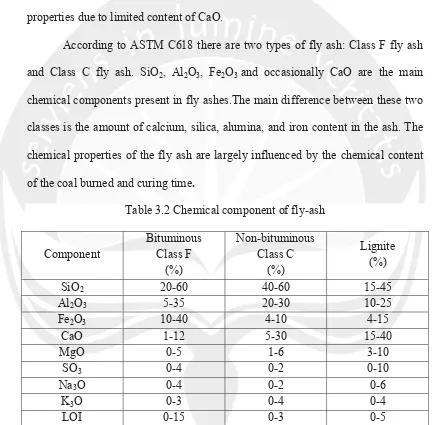9
Clay is type of soils that contain mostly very small fine particles. The particles of the clays are consists of silicates of aluminum/iron/magnesium. According to reference (Wikipedia, 2014; Braja, 2011) it is stated that clay is one of active mineral component of soil. It ismostly consist of crystalline and colloidal materials. In soils, clay is physically defined as any mineral particle less than 2μm (8×10−5in) in effective diameter. Chemically, clay is minerals with certain reactive properties on it. Clay minerals are complex aluminum silicates which is usually consist of two basic units: silica-tetahedron and alumina octahedron. Most clays are crystalline and most are made up of three or four planes of oxygen held together by planes of aluminium and silicon by way of ionic bonds that formed together becomes a single layer of clay. The spatial arrangement of oxygen atoms determines structures of the clay. On the clay structures Oxygen is half of its weight of, but on a volume basis oxygen is ninety percent. Sometimes, the layers of clay are held together through hydrogen bonds or potassium bridges and as a result swell less in the presence of water. Clays such as montmorillonite, have layers that are loosely attached and will swell greatly when water intervenes.
shrinkage problems. In dry condition the clay soils is hard enough, but in saturated condition clay soil’s strength decrease significantly. The other behavior
[image:2.595.88.517.198.564.2]of the clay can be seen on the table 3.1.
Table 3.1 Types of soils behavior
Source : (http://ed.wikipedia.org/wiki/clay at 2/10/2014;19:21)
Property/Behavior Sand Silt Clay
Water-holding capacity Low Medium-High High
Drainage rate High Slow-Medium Very Slow
Soil organic matter Low Medium-High High-Medium
Compact-ability Low Medium High
Susceptibility to erosion Moderate High Low
Shrink/Swell Potential Very Low Low Moderate-High
III.2. Fly Ash
Fly ash is the residues from coal burning process. Depend on source of the coal being burned, the components of fly ash vary considerably, but all fly ash includes substantial amounts of silicon dioxide (SiO2) and calcium oxide (CaO).
Fly ash particles are generally spherical in shape and range in size from 0.5 μm to 300μm.Fly ash is usually found as product of coal that burned in electric power generation facilities. Compared to other stabilizer such as lime and cement, fly-ash has little cementitious properties. Mostly fly fly-ashes belong to secondary binders; that cannot produce the desired effect on their own. However, if fly-ash is combined with small amount of activator, it can react chemically to form cementitious compound to improved strength of soft soil. Fly ashes are readily available, cheaper and environmental friendly.
produced from burning subbituminous coal; it has high cementing properties because of high content of free CaO. Class C from lignite has the highest CaO (above 30%) resulting in self-cementing characteristics. Class F fly ashes are produced by burning anthracite and bituminous coal; it has low self-cementing properties due to limited content of CaO.
According to ASTM C618 there are two types of fly ash: Class F fly ash and Class C fly ash. SiO2, Al2O3, Fe2O3and occasionally CaO are the main
[image:3.595.87.519.214.639.2]chemical components present in fly ashes.The main difference between these two classes is the amount of calcium, silica, alumina, and iron content in the ash. The chemical properties of the fly ash are largely influenced by the chemical content of the coal burned and curing time.
Table 3.2 Chemical component of fly-ash
Component
Bituminous Class F
(%)
Non-bituminous Class C
(%)
Lignite (%)
SiO2 20-60 40-60 15-45
Al2O3 5-35 20-30 10-25
Fe2O3 10-40 4-10 4-15
CaO 1-12 5-30 15-40
MgO 0-5 1-6 3-10
SO3 0-4 0-2 0-10
Na3O 0-4 0-2 0-6
K3O 0-3 0-4 0-4
III.3. Lime
According to references (Wikipedia, 2014), Lime is a calcium that contain inorganic material such as carbonates, oxides and hydroxidespredominate. Otherwise, lime is calcium oxide or calcium hydroxide. It is also the name of the natural mineral (native lime) CaO which occurs as a product of coal seam fires and in alteredlimestone xenoliths in volcanic paste. The word lime originates with its earliest use as building mortar and has the sense of sticking or adhering.
The rocks and minerals derived from these materials are the products such as limestone or chalk, that are composed primarily of calcium carbonate. They may be cut, crushed or pulverized and chemically altered. Burning process or usually called calcination converts them into the highly caustic material quicklime (calcium oxide, CaO) and, through addition of water, it can changes it into the less caustic but still strongly alkaline. Other products such as hydrated lime (calcium hydroxide, Ca(OH)2), is formed trough the process of which is called slaking of lime.
where water may be required to achieve effective compaction. In the other hands, presence of sulphur and organic materials may inhibit the lime stabilization process. Sulphate such as gypsum will react with lime and swell, which may have effect on soil strength.
III.4. Soil Stabilization
According to references (Wikipedia, 2014), soil stabilization is physical and chemical modification of soils to modify their physical properties. Stabilization of the soils can increase the shear strength of a soil and control the shrink-swell properties of a soil, thus improving the load-bearing capacity of a sub-grade to support that applied on its surface. Stabilization can be used to treat a wide range of sub-grade materials from expansive clays to granular materials. Stabilization can be achieved with a variety of chemical additives such as lime, fly ash, and Portland cement.
During the soil stabilizations process, pozzolanic reactions occurred due to adding of pozzolanic materials. Pozzolanic reaction is the reaction of pozzolan (lime, cement, fly-ash, kilin dust, etc.) to form cementitious product. The chemical reactions of pozzolan can be written as:
Ground performance is important to performance of the buildings. Soil stabilization is done in order to increase the following properties:
1. Shear strength : the ability to resist shear stresses developed as a result of loading;
2. Modulus (stiffness) : the ability to respond elastically and minimize permanent deformation when subjected to loading;
3. Resistance to moisture : the ability to resist the absorption of water, thus maintaining shear strength and modulus, and decreasing volumetric swell; 4. Stability – the ability to maintain its physical volume and mass when
subjected to load or moisture, and

